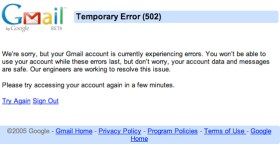 Google owns up to Gmail outage — Ben Treynor, the company’s VP Engineering and Site Reliability Czar, blogged openly today: “Right up front, I’d like to apologize to all of you — today’s outage was a Big Deal, and we’re treating it as such.” Here’s his tech explanation of what happened:
Google owns up to Gmail outage — Ben Treynor, the company’s VP Engineering and Site Reliability Czar, blogged openly today: “Right up front, I’d like to apologize to all of you — today’s outage was a Big Deal, and we’re treating it as such.” Here’s his tech explanation of what happened:
This morning (Pacific Time) we took a small fraction of Gmail’s servers offline to perform routine upgrades. This isn’t in itself a problem — we do this all the time, and Gmail’s web interface runs in many locations and just sends traffic to other locations when one is offline.
However, as we now know, we had slightly underestimated the load which some recent changes (ironically, some designed to improve service availability) placed on the request routers — servers which direct web queries to the appropriate Gmail server for response. At about 12:30 pm Pacific a few of the request routers became overloaded and in effect told the rest of the system “stop sending us traffic, we’re too slow!”. This transferred the load onto the remaining request routers, causing a few more of them to also become overloaded, and within minutes nearly all of the request routers were overloaded. As a result, people couldn’t access Gmail via the web interface because their requests couldn’t be routed to a Gmail server.
Internet cloud services fall short of five nines reliability — Telecommunications techs sometimes allude to what they call “five nines uptime,” a goal of 99.999% uptime that allows only five minutes per year of total downtime. Google’s uptime is exceptionally good, but today’s multi-hour Gmail outage blew their shot at five nines for the year Would you settle for three nines? A goal of 99.9% uptime would still allow Gmail or similar services to be down for eight hours out of each year. Today’s G-Fail will hopefully get people talking about what they’re willing to tolerate from free cloud computing services.
One-line comment in source code spawns speculation about Google’s plans for Chrome OS — “The name of the pipe over which the Chrome OS login manager will send single-sign-on cookies.” That’s the note in the source code for Google’s open-source Chromium project. A single sign-on system could be smart enough that whenever you login to Chrome OS on any computer, phone or whatever, it knows all the passwords for every site you use, so you needn’t do any more username/password typing past the single login to the Chrome OS. Sarah Perez worries that Google’s browser-based operating system won’t allow you to use a different browser. I dunno, that seems kind of pointless and counter to Google’s corporate culture of winning through better products rather than user lock-in. As long as Chrome works, people will stick with it anyway.
AI Weekly
The must-read newsletter for AI and Big Data industry written by Khari Johnson, Kyle Wiggers, and Seth Colaner.
Included with VentureBeat Insider and VentureBeat VIP memberships.
OK, enough Google! Sony has a 3-D television in the works for next year — “The company will announce plans for a new 3-D television at next week’s IFA consumer electronics show in Berlin,” says the Wall Street Journal, going with a rumor they think is true. Sony’s TV division has lost money for five straight years and needs a hit to turn it around. The Journal claims Sony is avoiding pricey technical wizardry in favor of affordable TVs, so maybe we’ll all get one. Most obvious concern: Will it play all 3-D movies, or just a fraction of them.
Yahoo Meme, a Twitter-wannabe service, launches as an invite-only beta — I know: Yahoo launches so many services that sink like rocks that you stopped paying attention when the company launched a Twitteresque service in Portugese, and then Spanish. Today, Yahoo added an English version. The company hasn’t answered Search Engine Land’s request for more info, nor have they informed any other reporters we could find about what’s going on with Yahoo Meme. Which is OK for now, since it’s not going to take off until the remove the beta-signup wrapper.
What kind of photos do people share on Twitter? YFrog, the photo add-on to Twitter, emailed journos a nice, mainstream-simple categorization of the Top 10 topics of the photos that Twitter users upload to YFrog.
1. Faces, people and self portraits
2. Food
3. Whereabouts (restaurants, beaches, stuck in traffic, etc)
4. Tattoos and body art
5. Cars
6. Beer and cocktails
7. Pets
8. Babies and children
9. Live event: concert, game
10. Video games and iPhone screengrabs
Yes, contrary to every single Apple demo of any photo or video product ever, people prove less likely to upload photos of their drinks than their kids.
VentureBeat's mission is to be a digital town square for technical decision-makers to gain knowledge about transformative enterprise technology and transact. Learn More

